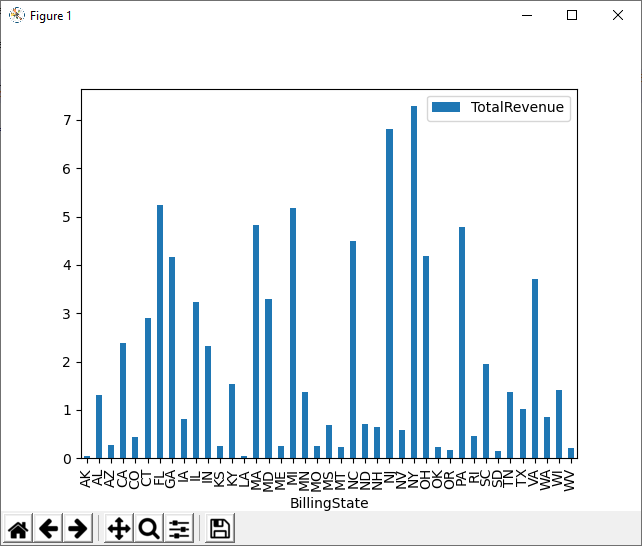Model Context Protocol (MCP) finally gives AI models a way to access the business data needed to make them really useful at work. CData MCP Servers have the depth and performance to make sure AI has access to all of the answers.
Try them now for free →How to Visualize Zoom Data in Python with pandas
Use pandas and other modules to analyze and visualize live Zoom data in Python.
The rich ecosystem of Python modules lets you get to work quickly and integrate your systems more effectively. With the CData API Driver for Python, the pandas & Matplotlib modules, and the SQLAlchemy toolkit, you can build Zoom-connected Python applications and scripts for visualizing Zoom data. This article shows how to use the pandas, SQLAlchemy, and Matplotlib built-in functions to connect to Zoom data, execute queries, and visualize the results.
With built-in optimized data processing, the CData Python Connector offers unmatched performance for interacting with live Zoom data in Python. When you issue complex SQL queries from Zoom, the driver pushes supported SQL operations, like filters and aggregations, directly to Zoom and utilizes the embedded SQL engine to process unsupported operations client-side (often SQL functions and JOIN operations).
Connecting to Zoom Data
Connecting to Zoom data looks just like connecting to any relational data source. Create a connection string using the required connection properties. For this article, you will pass the connection string as a parameter to the create_engine function.
Start by setting the Profile connection property to the location of the Zoom Profile on disk (e.g. C:\profiles\Zoom.apip). Next, set the ProfileSettings connection property to the connection string for Zoom (see below).
Zoom API Profile Settings
To authenticate to Zoom, you can use the OAuth standard to connect to your own data or to allow other users to connect to their data.
First you will need to create an OAuth app. To do so, navigate to https://marketplace.zoom.us/develop/create and click Create under the OAuth section. Select whether or not the app will be for individual users or for the entire account, and uncheck the box to publish the app. Give the app a name and click Create. You will then be given your Client Secret and Client ID
After setting the following connection properties, you are ready to connect:
- AuthScheme: Set this to OAuth.
- InitiateOAuth: Set this to GETANDREFRESH. You can use InitiateOAuth to manage the process to obtain the OAuthAccessToken.
- OAuthClientID: Set this to the OAuth Client ID that is specified in your app settings.
- OAuthClientSecret: Set this to the OAuth Client Secret that is specified in your app settings.
- CallbackURL: Set this to the Redirect URI you specified in your app settings.
Follow the procedure below to install the required modules and start accessing Zoom through Python objects.
Install Required Modules
Use the pip utility to install the pandas & Matplotlib modules and the SQLAlchemy toolkit:
pip install pandas pip install matplotlib pip install sqlalchemy
Be sure to import the module with the following:
import pandas import matplotlib.pyplot as plt from sqlalchemy import create_engine
Visualize Zoom Data in Python
You can now connect with a connection string. Use the create_engine function to create an Engine for working with Zoom data.
engine = create_engine("api:///?Profile=C:\profiles\Zoom.apip&Authscheme=OAuth&OAuthClientId=your_client_id&OAuthClientSecret=your_client_secret&CallbackUrl=your_callback_url&InitiateOAuth=GETANDREFRESH&OAuthSettingsLocation=/PATH/TO/OAuthSettings.txt")
Execute SQL to Zoom
Use the read_sql function from pandas to execute any SQL statement and store the resultset in a DataFrame.
df = pandas.read_sql("SELECT Id, JobTitle FROM MeetingRegistrants WHERE State = 'NC'", engine)
Visualize Zoom Data
With the query results stored in a DataFrame, use the plot function to build a chart to display the Zoom data. The show method displays the chart in a new window.
df.plot(kind="bar", x="Id", y="JobTitle") plt.show()

Free Trial & More Information
Download a free, 30-day trial of the CData API Driver for Python to start building Python apps and scripts with connectivity to Zoom data. Reach out to our Support Team if you have any questions.
Full Source Code
import pandas
import matplotlib.pyplot as plt
from sqlalchemy import create_engin
engine = create_engine("api:///?Profile=C:\profiles\Zoom.apip&Authscheme=OAuth&OAuthClientId=your_client_id&OAuthClientSecret=your_client_secret&CallbackUrl=your_callback_url&InitiateOAuth=GETANDREFRESH&OAuthSettingsLocation=/PATH/TO/OAuthSettings.txt")
df = pandas.read_sql("SELECT Id, JobTitle FROM MeetingRegistrants WHERE State = 'NC'", engine)
df.plot(kind="bar", x="Id", y="JobTitle")
plt.show()

